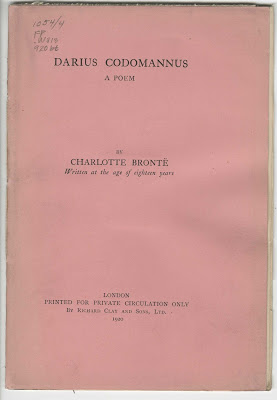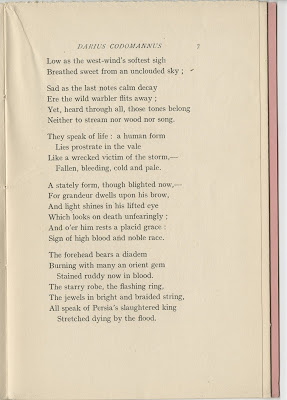Hi everyone! I’m Allison, the Rosenbach’s newest collections intern! I’ve just returned to Philadelphia after spending the past semester abroad in London, England. I was so excited to explore all of the works by all of the British authors at the Rosenbach. Eventually, I came across a number of works by Charlotte Brontë, but one in particular stood out: Darius Codomannus: A Poem. It was a poem by Brontë that I had never heard of. Granted, I am by no means well versed in all things Charlotte Brontë, but for some reason it stuck out in my mind.
 |
| Charlotte Brontë, Darius Codomannus: A Poem. London: privately printed, 1920. FP .W813 920 bt. The Rosenbach of the Free Library of Philadelphia |
Written in 1834, when Charlotte Brontë was just 18 years old, the poem tells the story of the defeat of Darius Codomannus, the last king of the Achaemenid Empire of Persia. Often referred to as “Death of Darius Codomanus,” the poem was written between her time as a student at Roe Head in Mirfield and as a governess at Roe Head. The poem was originally written in normal-sized script on lined paper and accompanied by other poems such as “Richard Coeur de Lion and Blondel” and “Saul”. It has been suggested that this group of poems shows that Bronte recognized that she needed to develop a public poetic mode to go along with her fantasy-based private writings. These poems were also said to have been similar to school exercises she wrote while in Brussels.
The poem, wasn’t published in her lifetime, but was eventually published in 1920. The small pamphlet, encased in a pink cover, is 16 pages. The last four
pages of the Rosenbach’s copy, however, are not cut open and therefore are unable to be read. It was published for private circulation only, with just 30 copies
made, which explains why is one of her least known poems and isn’t even included on many lists of Charlotte
Brontë’s works. The pamphlet was published by Thomas Wise and printed in London by Richard Clay and
Sons, Ltd. Thomas Wise had plenty of experience dealing
with Brontë’s work and had published a detailed bibliography of the Brontë
sisters.
 |
| Charlotte Brontë, Darius Codomannus: A Poem. London: privately printed, 1920. FP .W813 920 bt. The Rosenbach of the Free Library of Philadelphia |
Darius Codomannus, also known as Darius III, was the last king of the Achaemenid Empire of Persia and reigned from 336 BCE to 330 BCE. He was conquered during Alexander the Great’s quest to control all of Asia. In her poem, Bronte uses elegant verse to showcase the death of Darius Codomannus as well as highlight his importance to Persia. Darius died at the hands of his cousin, Bessus. Bessus stabbed him and left his dying body to be found later by Macedonian soldiers.
blighted now. –
For grandeur dwells upon his brow,
And light shines in his lifted eye
Which looks on death unfearingly ;
And o’er him rests a placid grace ;
Sign of high blood and noble race
Burning with many an orient gem
Stained ruddy now in blood.
The starry robe, the flashing ring,
The jewels in bright and braided string,
All speak of Persia’s slaughtered king
Stretched dying by the flood.
The poem proceeds to go into detail of what happened to lead up to his death. It tells of the betrayal by his cousin and how, inevitably, Persia was left without a king. His death gave Alexander the Great the ability to take control and Alexander became the official ruler of Persia. You can find the full text of the poem at Poetry Nook.
At one point in her life, Charlotte Brontë tried her hand at being a published poet, however was discouraged when she received a response from the poet laureate of England, Robert Southey. He said that literature could not be the business life for a woman and that she should be more engaged in her proper duties. Though it seems as though she respected his response, she continued to craft a number of poems. She eventually managed to publish a book of poems, aptly entitled Poems; however it did not sell well. It also did not include “Darius Codomannus.” After the publication of her novel Jane Eyre, Brontë stopped writing poetry except for three occasions, the deaths of her sisters. She is far better known for her novels than her poetry; however she is still respected as a poet.
Allison Darhun is a collections intern at the Rosenbach this
summer and a History major at St. Joseph’s University.
